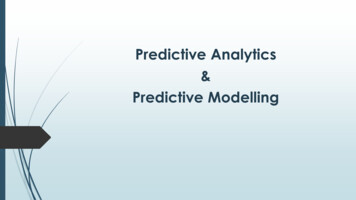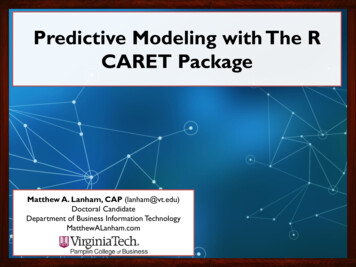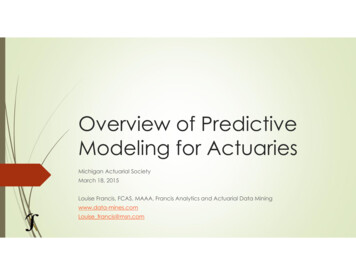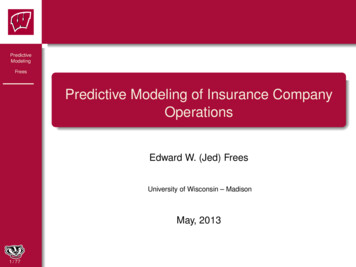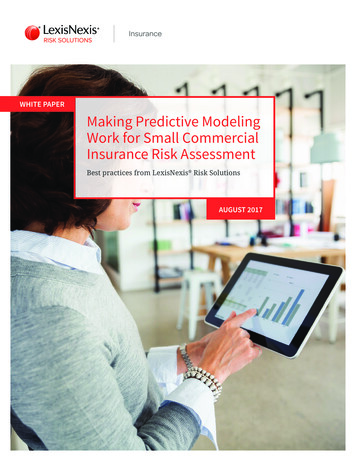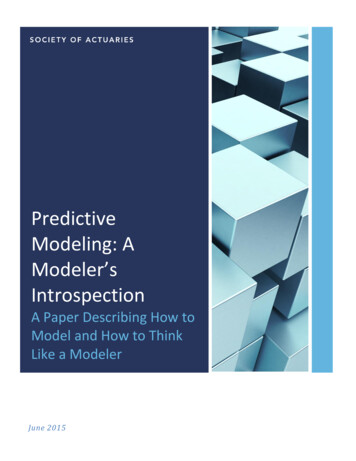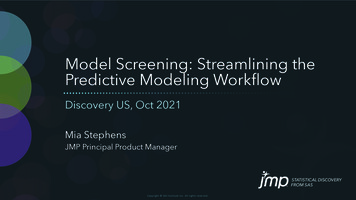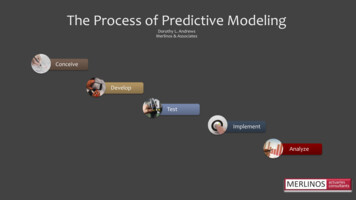
Transcription
The Process of Predictive ModelingDorothy L. AndrewsMerlinos & AssociatesConceiveDevelopTestImplementAnalyze
The Process of Predictive ModelingMy Background Actuary, ASA, MAAA MA – Mathematical Statistics MA – Mathematics & Education BA – MathematicsEverett Curtis Huntington Prize for BestActuarial Research Paper Outstanding Teaching Award 2002 – BUPredictive Modeling Practices PA Surveillance Model for the USDA Pathogen & Residue Sampling Techniques for Food Safety Big Dataset Handling: Banking & Reinsurance Scorecard Development to Evaluate Borrower Credit Risk Text Mining of Adjuster Notes for WC Predictive Modeling Analysis of Credit Data: Experian and Dun & Bradstreet Development of Enterprise Modeling Database United States Department of Agriculture Transamerica Reinsurance Company Big Dataset Handling: Banking & Reinsurance Harleysville Insurance Company Wachovia Corporation Develop & Implement Commercial Auto Predictive Model Deloitte & Touché LLP John Hancock Life Insurance Annuity Relational Database Development for Actuaries
The Process of Predictive ModelingToday’s Agenda Importance of Stakeholders Model Building Framework Model Validation & Monitoring Current Technologies for Modeling The Regulatory Environment
The Process of Predictive ModelingVs.Real Science
The Process of Predictive ModelingImportant Company Stakeholders & Partners C-Suite & Other Senior Management Actuarial Pricing Department Underwriting Department Information Technology Group Agents and Brokers
Underwriter Survey ResultsUnderwriter’s Perspective on Predictive Modeling: Welcome the opportunity to participate in review of the variables A small focus group to examine the intuitiveness of the new model The models should free underwriters to solve hard problems Agents need to be convinced that the models are valid for pricing The models need to identify previously undiscovered opportunities The underwriter needs to believe the models to get more rate
Impact of Excluding Underwriters Unclear on the utility of the model and most ignored model results Their field experience was not considered in the model design Variable results ran counter to how policyholders behave Little was communicated on the practicality of the model Some believed there is value but didn’t understand what it was Implementation of models was fractured across underwriters
Effective Partnering with Underwriters Underwriters do more than process information Recognize their insights as adding value to the process Partner to develop underwriting guidelines and in model building Use their intuition to interpret and “reality check” model results
Effective Partnering with Underwriters Discuss the strengths and weaknesses of the model with them Get the simple cases right so underwriters can focus on emerging risks Use their frontline observations of risks in variable development Don’t overlook the small stuff! – Doing that can lead to big problems!
Seminar: Expanding The Sample Topics:Toolset – Underwriting1. Underwriting & Actuarial CollaborationCollaboration2. Underwriting Decision-Making3. Tools for Risk Assessment & EvaluationOctober 22 – 23, 20154. Model Risk ManagementBoston, MA5. Predictive Analytics & Pricing6. Catastrophe Underwriting7. Telematics & Usage-Based Insurance8. Emerging Risk Assessment & Planning
Pre-Model Construction Considerations1. Understanding the market environment for model2. Understand the way participants think about risk factors3. Identify variables to treat stochastically vs. deterministically4. Develop qualitative interrelationships among variables5. Identify industry data on independent variables6. Identify company obstacles to successful model execution*Source: Goldman Sachs, Quantitative Strategies Research Notes, “Model Risk,” April 1996
Pre-Model Construction Considerations7. Identify external systematic risks impactful to results8. Develop actions to mitigate adverse risks9. Demonstrate the financial benefits of predictive models10. Identify hurdles to organizational knowledge transfer
The Process of Predictive ModelingPredictive Modeling Phases:Phase 1: Define Problem & Financial Impact of SolutionPhase 2: Understanding the Product to be Modeled Coverages Distribution Channels Underwriting System System Data Captured
The Process of Predictive ModelingPredictive Modeling Phases:Phase 3: Identify Internal & External Data Major Issue: Legacy SystemsPhase 4: Formulate Pre-Modeling Parameters Policy Term vs. Policy Time Period of Data Credit Data Proxy Development Variable Development & Analytics
The Process of Predictive ModelingPredictive Modeling Phases:Phase 5: Iterative Data Scrubbing & Cleansing Missing & Mis-specified Data Fields Combine Internal & External Data Control Total Reconciliation Data Accuracy Criteria Visual & Descriptive Analytics Legal & Underwriting Review of Variables
The Process of Predictive ModelingPredictive Modeling Phases:Phase 6: Model Construction Frequency x Severity Tweedie Distribution Cluster/Principal Components Machine Learning Using C4.5 Generalized Linear Models Stepwise Variable Elimination
The Process of Predictive ModelingPredictive Modeling Phases:Phase 7: Interpretive Model Support Analytics Correlation Matrices ROC & Decile Lift Curves Disruption Analysis Probability Plots Model Fit Metrics Validation Review
The Process of Predictive ModelingPredictive Modeling Phases:Phase 8: Systems Integration, Testing & Implementation Dashboard Analytics Reason Code Development Convert Scores to Business Rules Independent Validation of IT Implementation Development of Monitoring Metrics Develop Documentation & Training Material
The Process of Predictive ModelingHow do we knowthe model is “right”?Recognizing the “wrong” model is easier thanqualifying the “right” model.Model validation can help assess whether amodel is a reasonable representation of thephenomena under study. But remember themodel is only a model of the phenomena andnot the real thing. This means we can’tremove the human element from themodeling process.
Types of Model RiskModel Risk -“The risk of loss by using a model to make financial decisions.”1. Inapplicable Model2. Incorrect Model3. Correct Model, Incorrect Solution4. Correct Model, Inappropriate Use5. Badly Approximated Model6. Software and Hardware Bugs7. Unstable DataSource: Goldman Sachs, Quantitative Strategies Research Notes, “Model Risk,” April 1996– Goldman Sachs
Signs Model May Be Incorrect1. Important factors not considered2. Stochastic variables estimated with deterministic variables3. Incorrect dynamics assumed for a factor4. Model inappropriate for current conditions5. Correct under ideal circumstancesSource: Goldman Sachs, Quantitative Strategies Research Notes, “Model Risk,” April 1996
Signs Model May Be Incorrect6. Only approximate under real-life situations7. Correct in principle but limited in the short term8. Underlying data not robust enough to fully model phenomena9. Model reasonable, but world unstableSource: Goldman Sachs, Quantitative Strategies Research Notes, “Model Risk,” April 1996
The Process of Predictive Modeling“Essentially, all models are wrong,but some are useful.”- George E.P. Box
The Process of Predictive ModelingMitigating Model Risk:1. Regard models as interdisciplinary endeavors2. Know what constitutes a warning sign3. Test complex models using the simple cases first4. Test the model’s boundariesSource: Goldman Sachs, Quantitative Strategies Research Notes, “Model Risk,” April 1996
The Process of Predictive ModelingMitigating Model Risk:5. Don’t ignore small discrepancies6. Provide a good user interface7. Diffuse the model slowly to an expanding group8. Pride of Ownership – Model builders should like to build modelsSource: Goldman Sachs, Quantitative Strategies Research Notes, “Model Risk,” April 1996
Current Technologies for ModelingTechnologyProgrammingGLM MethodMachine esSASYesYesYesYesYesOnly onScreenYesOnly onScreenDataRobotSkytreeNoNoYesNoTalonNoYesYesYes – ExcelFilesEmblemNoYesNoYes
The Mission of the Regulatory Process Prevent unfair discrimination in risk selection & pricing Regulatory are keenly interested in Model variables Reliance on other models Any model relied upon must be included in the filing Regulators disallow unfairly discriminatory variables & models Consult with legal counsel on variable selection
The Process of Predictive ModelingData Sources to Avoid in P&C Modeling?:1. Consumer Transactions – B2C Data2. Pharmaceutical Transactions3. Political Affiliations Data4. Aggregate Household Information5. Individual Household Information6. Customer – Focused Marketing DataAcxiom’s data and technology havetransformed marketing – giving ourclients the power to successfullymanage audiences, personalizecustomer experiences and createprofitable customer relationships.www.acxiom.comMarketing Data Sources: www.infousa.com www.nielsen.com www.infogroupmediasolutions.com www.wpcurve.com
Questions?
The Process of Predictive Modeling. Predictive Modeling Phases: Phase 3: Identify Internal & External Data Major Issue: Legacy Systems Phase 4: Formulate Pre-Modeling Parameters Policy Term vs. Policy Time Period of Data Credit Data Proxy Development Variable Development & Analytics


